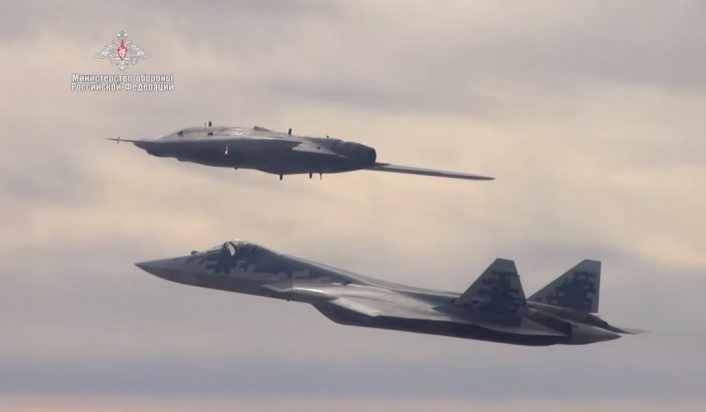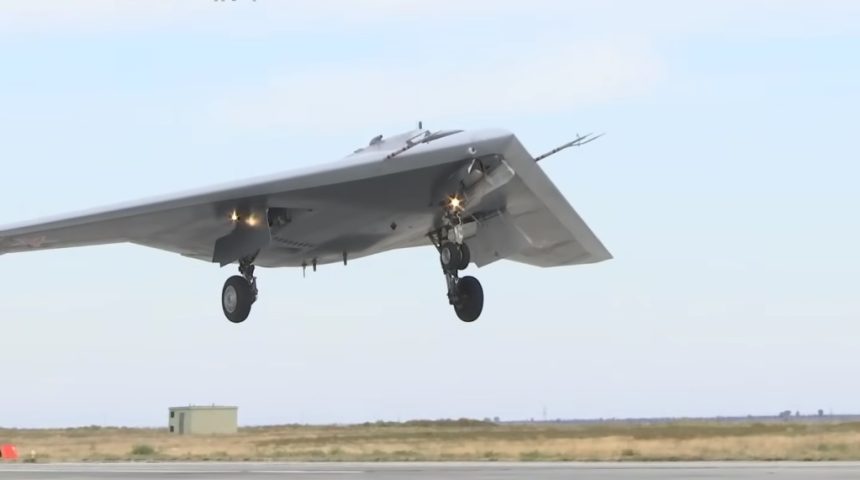In December it was also announced that the S-70 Okhotnik drone was tested in flight with captive air-to-air missiles in the fighter role
The Russian next-generation Unmanned Combat Aerial Vehicle (UCAV) Sukhoi S-70 Okhotnik (Hunter) struck some ground targets in the Ashuluk range (home of the Russian Aerospace Forces’ Combat Training and Combat Application Center) in southern Russia, according to a source in the military-industrial complex cited by the Russian News Agency RIA Novosti. The drone hit the target with high accuracy using 500 kg (1100 lb) free-fall unguided bombs, likely the standard FAB-500 M-62 bomb used by Russian aircraft, carried in the weapons bay.
The source did not disclose when this test happened, but mentioned that this was not the first bombing test of the drone. Further details included that the UCAV may have been recently upgraded to add new capabilities, as the source was quoted as saying that “the newest sighting and navigation system installed on the Okhotnik makes it possible to use free-falling ammunition with an accuracy approaching that of a high-precision guided weapon.”
Interestingly he added that the S-70 can autonomously engage “stationary and restrictedly mobile ground targets” with known coordinates, either preplanned or received from another source while inflight. While this could be just speculation, the few details disclosed by the source may suggest that the drone is using a Continually Computed Release Point (CCRP) method of bombing, normally used when the target’s coordinates are known.
This method involves a computer calculating the optimal release point for the bomb to hit the target, taking into account the aircraft flight parameters (speed, altitude, etc), the weapon’s parameters (speed, drag, etc), the target position and eventually its movements, as opposed to Constantly Computed Impact Point (CCIP) where the pilot has to put a pipper, which indicates the desired impact point, right on target, usually in a dive.
However, if the target is moving after the bomb release, the new changes in the position will not be taken into account, making a hit possible only if the target is moving very slowly. Obviously, in that case a direct hit would be much less probable than a hit by shrapnel in the immediate vicinity of the target (unless guided weapons are used).
The bombing test of the Okhotnik, which first flew in 2019, was preceded about a month ago by the announcement of the testing with air-to-air missiles in the fighter role. This test also happened over the Ashuluk range and was reportedly the first weapon testing performed after months of assessments of the flight qualities and on-board systems.

After the air-to-air test, a source mentioned by RIA Novosti said that several flights were performed captive training missiles, which are identical to the live missile but missing the rocket engine and the warhead. Both IR-guided and radar-guided missiles were used to assess the UCAV’s avionics coupled with the missile guidance systems and the Su-57 “Felon” which was accompanying the drone. This could be a further demonstration that the S-70 could be intended also to act as a “Loyal Wingman” for the Su-57 in future.
The type of the weapons was not specified, other than saying that they were both IR-guided and radar-guided missiles. This would somewhat restrict the field to the R-73/AA-11A Archer IR-guided short-range missile and its derivate R-74/AA-11B Archer, and the R-77/AA-12 Adder active radar-guided medium range missile.
The R-73 and R-74 are the standard short-range air-to-air missile of the Russian Aerospace Forces, with the latter being further upgraded to a new K-74M2 variant, designed to be fired from the Su-57’s side weapon bays. This variant reportedly includes a lock-on after launch (LOAL) capability, meaning that the missile can be launched without guidance and it will acquire its target once in flight.
If the reports about the R-74M2 variant are correct, it would make sense to use it aboard the Okhotnik, as the IR sensor of the missile can’t achieve a lock before launch while it is inside the weapon bays, unless there is a mechanism that extends the missile launcher into the airstream during the targeting process. In that case, the LOAL capability would not be essential and the UCAV could also use the standard R-74 and R-73.
Regarding the R-77, considered to be the Russian counterpart of the AIM-120 AMRAAM, the missile is currently being tested in a specially designed variant for the Su-57, called R-77M. This missile, based on the upgraded R-77-1/AA-12B currently in service on the Su-27SM, Su-30SM and Su-35S (and according to some sources also on earlier Su-27s and MiG-29, although there is no photographic evidence of its use in operational role), has been redesigned to fit inside the weapon bays, with the main difference being the replacement of the grid fins on the missile’s tail with standard fins.
The missile should include a dual-pulse rocket motor for improved high-altitude maneuvering and extended range (rumored up to 100 miles, doubling the range of previous variants), an enhanced AESA radar sensor, improved Electronic Counter-Countermeasures (ECCM), better aerodynamics and reduced radar cross section (the last two mainly due to the new fins). With all these characteristics and the design optimized to fit inside the weapon bays, the R-77M could be the main candidate to be carried by the S-70.
There are also reports about another variant of the Adder, called R-77PD, which is powered by a combined rocket-ramjet engine, much like the European MBDA Meteor BVRAAM (Beyond Visual Range Air-to-Air Missile). Details about this variant are scarce and it is not known if it will be acquired by the Russian Aerospace Forces.
The commonality of the weapons between the S-70 and the Su-57 could be another hint to the future role of the UCAV. In the past, the Russian government said the drone would extend the radar coverage of the Felon and provide target acquisition, while also being able to attack its own targets autonomously. The Russian Ministry of Defense expects the first deliveries of the drone to happen in 2024, so we will likely know more about its role as we get closer to that deadline.
According to some sources, the Okhotnik could perform live air-to-air missile launches this year, this has not been confirmed. However, it would not be the first time for a drone, as the MQ-9 Reaper already fired live AIM-9X Sidewinder missiles in 2017 and 2020 and, even before, the MQ-1 Predator launched the AIM-92 ATAS (Air-to-Air Stinger), including one fired in 2002 at an Iraqi MiG-25.








